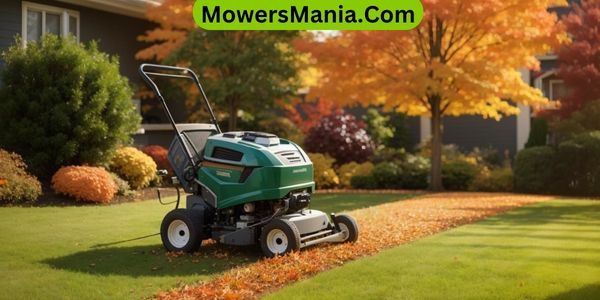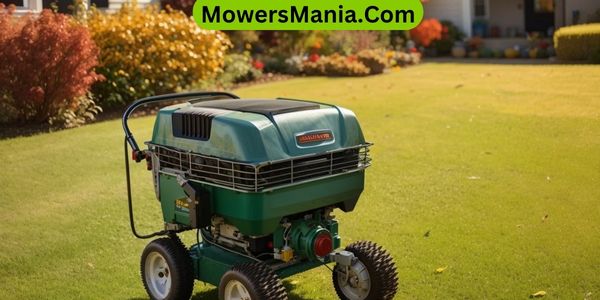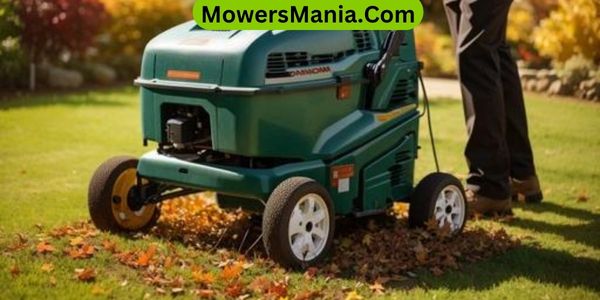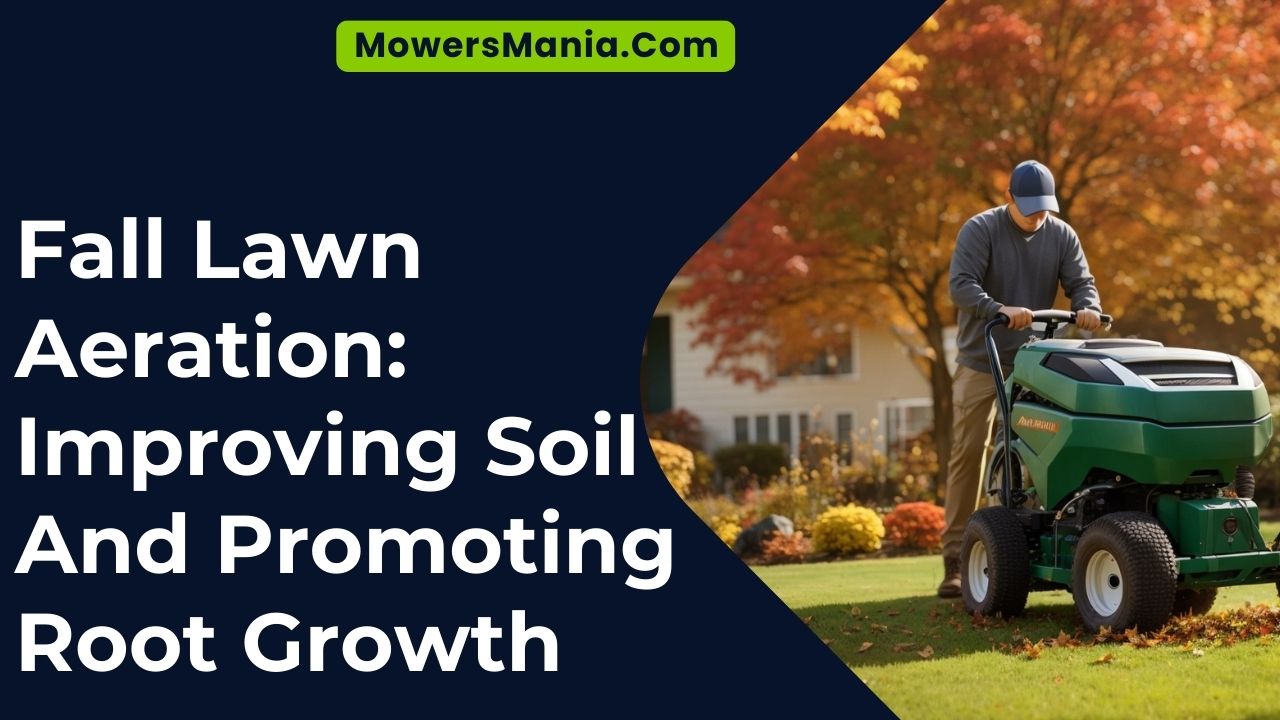Are you looking to improve your soil and promote stronger root growth? Fall lawn aeration is the answer! By aerating your lawn, you can enhance nutrient absorption and create a healthier, greener lawn.
In this article, we will explore the importance of fall lawn aeration, the benefits of soil improvement, and how aeration helps promote stronger and deeper roots.

Plus, we’ll provide tips on choosing the right aeration method for your lawn. Don’t miss out on the key to a thriving lawn this fall!
Importance of Fall Lawn Aeration
You should understand the importance of fall lawn aeration. By aerating your lawn in the fall, you can greatly improve the overall health and appearance of your grass.
Aeration involves the process of creating small holes in the soil to allow for better air, water, and nutrient penetration. This is crucial because compacted soil can prevent these essential elements from reaching the roots of your grass.
Furthermore, aeration helps to break up thatch, which is the layer of dead grass, roots, and other organic matter that accumulates on the surface of your lawn. When thatch becomes too thick, it can hinder proper water and nutrient absorption, leading to a weak and unhealthy lawn.
By aerating your lawn in the fall, you give your grass a better chance to develop a deep and robust root system. This is important because strong roots are essential for withstanding the harsh winter conditions and promoting healthy growth in the following spring.
Benefits of Soil Improvement
You’ll be pleased to know that improving your soil comes with several benefits.
- Firstly, it enhances nutrient absorption, allowing your plants to receive the necessary nourishment for optimal growth.
- Secondly, soil improvement reduces soil compaction, creating a looser and more aerated environment for roots to penetrate and establish themselves.
Enhanced Nutrient Absorption
Improve your lawn’s nutrient absorption through enhanced soil quality. When your soil is healthy and well-nourished, it provides the perfect environment for your plants to thrive.
By aerating your lawn in the fall, you can improve soil structure and promote deeper root growth, allowing for enhanced nutrient absorption. But what exactly does this mean for your lawn?
Let’s take a look at the benefits of soil improvement in a table format:
| Benefits of Soil Improvement |
|---|
| 1. Increased nutrient availability |
| 2. Enhanced water retention |
| 3. Improved microbial activity |
Reduced Soil Compaction
Reduced soil compaction increases the air and water movement within the soil, allowing for better nutrient uptake by your lawn.
When the soil is compacted, it becomes dense and hard, making it difficult for air and water to circulate freely. This restricts the movement of essential nutrients, preventing them from reaching the roots of your grass.
However, by aerating your lawn and loosening the soil, you create channels for air, water, and nutrients to penetrate deep into the ground. As a result, the roots of your grass can access the nutrients they need to grow strong and healthy.
Promoting Stronger and Deeper Roots
To promote stronger and deeper roots in your lawn, it’s essential to engage in fall lawn aeration. Aeration helps improve the overall health of your lawn by allowing air, water, and nutrients to penetrate the soil more effectively. This, in turn, encourages root growth and development, leading to a healthier and more resilient lawn.
Here are three reasons why promoting stronger and deeper roots through aeration is crucial:
- Enhanced nutrient absorption: When the soil is compacted, it becomes difficult for roots to access essential nutrients. By aerating your lawn, you create channels for nutrients to reach the root zone, resulting in improved absorption and utilization by the grass.
- Increased drought tolerance: Deep roots are better equipped to withstand periods of drought. By aerating your lawn, you encourage deeper root growth, enabling your grass to access water stored in the lower layers of the soil. This helps your lawn stay green and healthy even during dry spells.
- Improved disease resistance: Aerating your lawn helps create an environment that discourages the growth of disease-causing organisms. By allowing air circulation and reducing excess moisture, you minimize the risk of fungal diseases and other lawn issues.
How Aeration Helps Nutrient Absorption?

When it comes to nutrient absorption, aeration plays a crucial role. By creating small holes in the soil, aeration allows nutrients to reach the roots more easily, resulting in increased nutrient uptake by the grass.
Additionally, aeration promotes enhanced root development, allowing the roots to grow deeper and spread wider, further improving their ability to absorb nutrients.
Increased Nutrient Uptake
How does aeration improve nutrient absorption in your lawn? Aeration plays a crucial role in enhancing nutrient uptake, ensuring a healthy and vibrant lawn.
Here’s how it works:
- Loosens compacted soil: Aeration breaks up compacted soil, allowing nutrients to penetrate deeper into the root zone.
- Increases oxygen flow: By creating small holes in the soil, aeration improves oxygen circulation, enabling roots to absorb nutrients more efficiently.
- Enhances root growth: Aeration stimulates root development, resulting in a denser and more extensive root system. This increased root mass allows for better nutrient absorption.
Overall, aeration improves nutrient absorption by providing a favorable environment for roots to access the essential elements they need to thrive.
Enhanced Root Development
Aeration continues to enhance root development, aiding in the absorption of nutrients by your lawn. When your lawn is aerated, small holes are created in the soil, allowing air, water, and nutrients to reach the roots more easily. This improved access to nutrients is crucial for the overall health and vitality of your lawn.
As the roots grow stronger and deeper, they can absorb nutrients more efficiently, leading to greener and thicker grass.
Aeration also helps to break up compacted soil, which can prevent nutrients from reaching the roots. By loosening the soil, aeration promotes healthy root growth, allowing your lawn to better absorb essential nutrients and thrive.
Choosing the Right Aeration Method
To achieve optimal results, you should select the appropriate method for aerating your lawn. The right aeration method can make a significant difference in improving soil health and promoting root growth.
Here are three options to consider:
- Core Aeration: This method involves removing small plugs or cores of soil from your lawn. It helps to reduce soil compaction and allows air, water, and nutrients to penetrate the soil more effectively. Core aeration is particularly beneficial for heavy clay soils or areas with high foot traffic.
- Spike Aeration: Spike aeration involves poking holes in the soil using solid tines or spikes. While it can provide some benefits by creating channels for air and water, it may not be as effective in relieving soil compaction as core aeration. Spike aeration is a simpler and less costly method, making it a good option for smaller lawns with less severe compaction.
- Liquid Aeration: This method involves applying a liquid solution to the lawn that helps break up compacted soil. Liquid aeration can be a convenient option for homeowners who prefer a non-invasive approach. However, it may not be as effective as physical aeration methods in relieving soil compaction.
Tips for Effective Fall Lawn Aeration

Maximize the effectiveness of your fall lawn aeration by following these key tips. Aeration is an important step in maintaining a healthy and lush lawn, and with the right techniques, you can ensure that your efforts yield the best results.
Here are some tips to help you get the most out of your fall lawn aeration:
| Tips for Effective Fall Lawn Aeration |
|---|
| Choose the right time: Aerate your lawn during the fall when the soil is moist but not overly saturated. This allows for easier penetration and reduces compaction. |
| Use the correct equipment: Invest in a core aerator or hire a professional lawn care service to ensure proper aeration. Spike aerators can actually worsen compaction, so it’s best to avoid them. |
| Follow a pattern: Aerate your lawn in a crisscross pattern to ensure complete coverage. This helps to break up compacted soil and allows air, water, and nutrients to reach the roots more effectively. |
Frequently Asked Questions [FAQs]
How Often Should I Aerate My Lawn in the Fall?
You should aerate your lawn in the fall at least once every year. This will help improve soil conditions and promote root growth, leading to a healthier and more vibrant lawn.
Can I Aerate My Lawn Without Using Any Equipment?
Yes, you can aerate your lawn without using any equipment. One alternative method is to use a garden fork or a pitchfork to manually create holes in the soil to improve its health.
Will Aeration Help With Weed Control in My Lawn?
Aeration can help with weed control in your lawn by reducing soil compaction and allowing nutrients and water to reach the roots. This helps the grass to grow stronger, making it harder for weeds to take hold.
Can I Aerate My Lawn if It Has Recently Been Seeded?
Yes, you can aerate your newly seeded lawn. Aeration will help improve soil quality and promote healthy root growth for your new grass. It’s important to wait until the grass has germinated before aerating.
Should I Water My Lawn Before or After Aerating?
You should water your lawn before aerating. This helps soften the soil, making it easier for the aerator to penetrate. Plus, it ensures that the moisture reaches the roots, promoting healthy growth.
Conclusion
In conclusion, fall lawn aeration is a crucial step in improving soil quality and promoting stronger and deeper root growth.
By allowing for better nutrient absorption, aeration helps your lawn thrive and stay healthy.
Choosing the right method of aeration and following some tips for effectiveness can ensure the best results.
So don’t forget to aerate your lawn this fall and reap the benefits of a beautiful and vibrant lawn.



